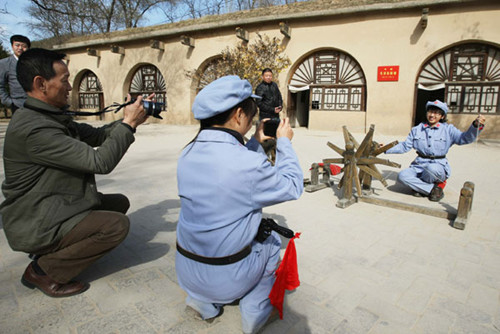
Tourists dressed as Red Army soldiers pose for pictures at the Zaoyuan historical site in Yan'an, Shaanxi province (File Photo: Xinhua/Li Fangyu)
It was exactly 80 years ago that the Long March-the strategic march of the Red Army that trudged and fought its way through thousands of miles across China-ended in the rugged, cave-riddled mountainous terrain of Yan'an in Northwest China's Shaanxi province. Yan'an was then (as it still is) something of a frontier, a waylaid place of farmers with miserable climate (stuffy summers and frigid winters), yet a place with a surprisingly delectable and distinct cuisine.
But history was made in Yan'an: the regrouping of the communist guerrillas and the ascent of Mao Zedong, eventually leading to the triumph of the revolution. It's a history that has put Yan'an on the tourist map: the sprawling revolutionary sites are visited by millions of tourists every year.
Yan'an is one of half a dozen sites in China that have become very popular tourist spots associated with the revolution. These sites have been given the collective moniker of "red tourism", which has seen dramatic growth over the past decade. Tens of millions of tourists now visit "red tourism" sites every year.
The growth in "red tourism" has been largely organic, although the Chinese government has facilitated the process by improving the infrastructure and pumping money into funding the restoration and expansion of these sites. There was a time when these sites were sober places visited regularly only by government and Party officials on study tours, but now commercialization has followed on the heels of mass tourism.
Purists like me might bemoan the commercialization and the theme-park atmosphere, but the brash and comical commodification is not limited to red tourism sites. Commodification pervades all of China's famous tourist spots, even remote villages and national parks. The question is whether the average tourist takes back home a moral more profound than souvenirs and selfies.
I believe people are attracted to revolutionary sites for a variety of reasons. One of the main reasons is the current faddish allure of history, a fad that is also manifested in red-themed bars that have sprouted across China-bars decorated with pop-like revolutionary posters and mementoes, and interior designs based on a red-color scheme.
Another reason people are attracted to revolutionary sites is the respect for the selfless revolutionary struggle and ideological goodwill that the revolution heralded. At the "red tourism" sites people feel nostalgic, recalling and reliving the time when people were inspired by greater ideas, ideas that put the collective far above the personal.
Peeping into the cave buildings in Yan'an where the revolutionaries lived or walking on the flimsy Luding Bridge across a fast-flowing river in the mountains which the revolutionaries had to fight enemy forces to cross, you can't help feeling stirred by the revolutionaries' doggedness and struggle, and bow in reverence to their selfless idea of building a fairer China. It's an idea that has resonance today.
Another lasting impression of the "red tourism" sites is the sense of protracted history, for they uncannily seem older than they actually are, and that serves to demonstrate how far China has progressed. And given such countrywide progress, the "red tourism" sites are not only places of nostalgia, they also serve to inspire and connect the past with the present.
The author Victor Paul Borg is a freelance writer who specializes in culture, travel, and lifestyle.


















































